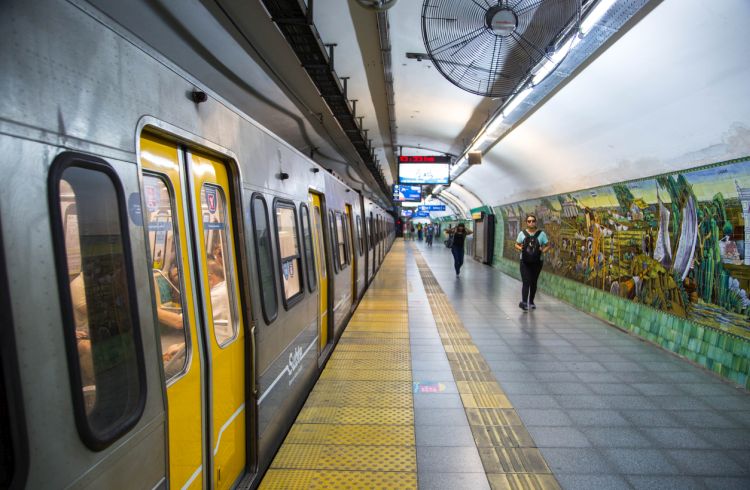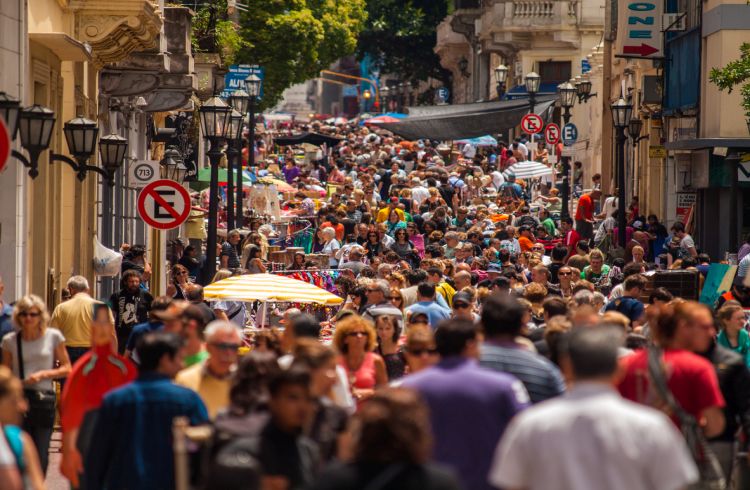Transport Tips: How to Get Around Buenos Aires Safely
Buenos Aires is one of South America's most exciting and vibrant cities. While the city is relatively safe, here are some tips to stay safe on public transport.
 Photo © iStock/Goddard_Photography
Photo © iStock/Goddard_Photography
From the popular Caminito strip and Casa Rosada to the charismatic nightlife scene, there’s always something to see or do in Buenos Aires. With so many neighborhoods to check out, chances are you’ll be out and about from dusk to dawn.
The good news is that Buenos Aires is relatively safe compared to its South American counterparts. Most of the inner city streets and neighborhoods are clean, well maintained and well-lit at night. Plus, the public transport system, especially the bus service, has had a spruce up in recent years.
But there are little nuances to navigating your way around the city. So before you take a stroll through La Boca, or hit up one of the city’s all-night boliches (nightclubs with dancing), it pays to read up on the best ways to get around this city quickly and safely. The last thing you want is to end up in the wrong part of town or to stand around looking lost.
- Public Transport in Buenos Aires
- Local Buses and Subway
- Stay Safe - Hold on Tight
- Guia T - Pocket Guide to Buenos Aires
- SUBE - Buenos Aires Transport Card
Public transport in Buenos Aires
If it’s your first time in the city, you'll probably be calling Palermo, Recoleta or Puerto Madero home for a few days. These neighborhoods are popular with visitors and expats, and as soon as you step out of your hotel you’ll find just about everything you need to experience Buenos Aires’ hottest dining and club scenes.
But burst through these cosmopolitan bubbles, and you’ll discover there’s so much more to explore, and public transport can be a great, affordable way to see it all.
Note: if you’re traveling alone late at night, especially females, it’s best to avoid the subway. Opt for a registered taxi or travel with a friend instead.
Local buses and subway
Previously shunned by the middle or upper class, the Colectivo (local bus) and the
There’s a service that runs through, or close to, all popular destinations and attractions. But keep in mind this is a city of about three million people, so it can get pretty crowded, especially during weekday peak periods, which are around 8-9am and 6-8pm.
As you would in any crowded area while traveling, make sure you stay alert and watch out for pickpockets who might bump or slide up against you.
You’ll be quick to notice even locals keep their belongings, such as handbags and laptop bags, very close to them while traveling around. Wear bags across and over your shoulder if possible, and zip them shut. Don’t forget to leave your valuable jewelry at home. Wearing anything sparkly on public transport (or anywhere in South America, for that matter) is a big no-no.
If you’re more of a backpacking kind of nomad, you’ll want to wear your bag around your front, not your back.
Depending on the neighborhood, avoid standing around flicking through your smartphone on public transport (or on the streets) either. La Boca, especially just outside of the main Caminito area, and Retiro, mainly around the market and train station, are two popular visitor destinations where you’ll want to stay on your guard. That witty social media post isn’t worth tempting even the most rookie criminal! So keep it in a safe, closed section of your bag or in one of your front pockets. That goes for wallets, too.
Stay safe - hold on tight
Another safety tip is to get on or off the bus and train quickly and to hold on tight.
On most streets and roads, the bus won’t pull up to the curb, even if there’s a queue. Sometimes, the bus will barely make a complete stop to let people on and off, so you’ll need to be on your A-game. Also, watch out for cyclists in the bike lane or motorcyclists zipping nearby before you get on or off.
Once the last person has stepped up, drivers are quick to close the doors and drive off again. It’s followed by a rollercoaster of a ride, so grab a seat or hold on to something quick!
This all makes for a quick and efficient ride, but a somewhat chaotic one too! Some travelers have reported their ankles or shoes getting stuck in the door before they’ve fully got on board or off their bus or train.
Guia T - pocket guide to Buenos Aires
If you’re planning on finding your own way around Buenos Aires, a Guia T will be your best friend. It’s a pocket guidebook of the city’s 100+ bus lines and tiny maps of the streets, roads, and intersections too. It’s handy for navigating the public transport system and for pedestrians as well. Even the
You can pick one up at kiosks and newsstands around the city, and it will cost around 5 pesos.
Got internet access? In January 2016, Google Maps upgraded its public transport function to include the metropolitan area of Buenos Aires. Around 800 routes and 34,000 bus and train stops in the BA metro area were added to the Google Maps app, which means you can now type in your location and destination in and the app will work out the best route for you.
SUBE - Buenos Aires Transport Card
Recently, the city moved to an electronic card system, so instead of loose change, you’ll now need a SUBE card to travel on the bus and subway.
You can buy a SUBE (pronounced “soo-
'un
You can buy one card per person, or if you’re traveling in a small group or as a couple, you can also use one card for multiple people on the same trip.
To use the bus, you’ll need to tell your driver the destination first (bet you’re glad you picked up that Guia T first, right?), then for the correct fare, tell the driver where you’d like to get off (by cross street, or name if it’s a well-known destination), and the driver will program your fare into the card reader.
Then you tap your card, and you’re done. There’s no need to tap off at the end of the trip. Another way is to tell the driver how much to charge. To travel seven to 10 blocks, or say a few miles, you’ll need three to four pesos. So, you could say "cuatro pesos,
Related articles
Simple and flexible travel insurance
You can buy at home or while traveling, and claim online from anywhere in the world. With 150+ adventure activities covered and 24/7 emergency assistance.
Get a quote

7 Comments
That looks like really useful info, thanks. Any more like that on BA would be good.
If think the one who wrotte this article should GO to Buenos Aires and other cities of South America before writting this.
Lots of prejudice about safety tips. I have been to many countries and cities in South America and most of them are very safe, civilized and friendly. The same tips that applies to some big cities in Europe (such us Paris) applies to some big cities South America.
The Sube is great. Stations everywhere. However when trying to buy a sube card its very hard. Whilst there are shops everywhere to top up your card there are very few places to actually buy the card in the first place. If trying to buy a card after about 4pm then you will have to go about 15 blocks from the obelisk to do this where there is a minimum charge of about 100pesos. This includes the price of the card and credit. Each subway ride is 5 peso each no matter the distance
As of March 2017, it costs 25pesos to buy a SUBE card. You can purchase and load the card at Subway stops or at select kiosks. Subway rides start at 7.5 pesos and the price goes down the more rides you take. The cards canalso e used on the buses No integration between bus and subway so if you transfer you must pay again
Hi Phil, this is a great article about public transport in Buenos Aires. I would say that the Como Llego app is now a much easier way to work out the bus system in Buenos Aires than using the Guia T. Unfortunately the cost of the bus and subway have also gone up quite a lot since you write that article due to inflation. I recently wrote a more updated blog post on getting around in Buenos Aires that might have some useful up-to-date information. http://blog.ailolabuenosaires.com/2017/11/03/how-to-get-around-in-buenos-aires/
Thanks!
Sophie
I've lived in Buenos Aires for 2 months. It seems the further north and the further east you go the safer it is. I lived in Belgrano and it felt reasonably safe to me. Some places feel very safe. Outside of La Boca, a popular tourist spot (in the south of the city limits) is not to be trifled with. We met a man who works at a shop there is told us point blank if we stay they after dark we will be robbed. It was fine in the day time though. Places like Polermo and Belgrano felt the safest. Puerto Meduero is nice but if I'm ever there at night I will be taking a taxi, there is slums within walking distance. Also some of the richer more glamorous neighborhoods on occasion are targeted for robberies, places like San Telmo, or Recolletta.
As far as public transport is concerned the subway system is great but stifling hot in the summer time. You can buy a Sube card at any subway station. It will work for subways and busses. 10$ should be enough to get you around the city for a week! The busses are crazy like they mentioned, once I was almost thrown to the ground in a bus when it slammed on the brake and you always need to hold on tight. Jumping on or off is a thing. Make sure you have enough money on your sube card, the buses only take sube cards now. I once ran out of credit on my sube card and had to walk miles to the nearest subway station.
Another thing they didn't mention is that cars practically will run your ass over! Pedestrians do not have the right of way! You look at the light in the signal not what the crosswalk says. If the light is green in your direction you can walk but look for cars that are making a turn. You may have to stop midstride as they drive around you or wait still. I'm from the west coast and here people act like they are invincible when they cross the street because they have the right if way and that is respected by most drivers. If you are used to that get it out of your head, you have to watch your ads, but if found you will be fine.
The mentioned guia T=de transportes is NOT for sale anymore-since by now at least some 4-5 years. Not that it was really the goldmine of info nyou describe, it was a very difficult to understand and badly printed thing.